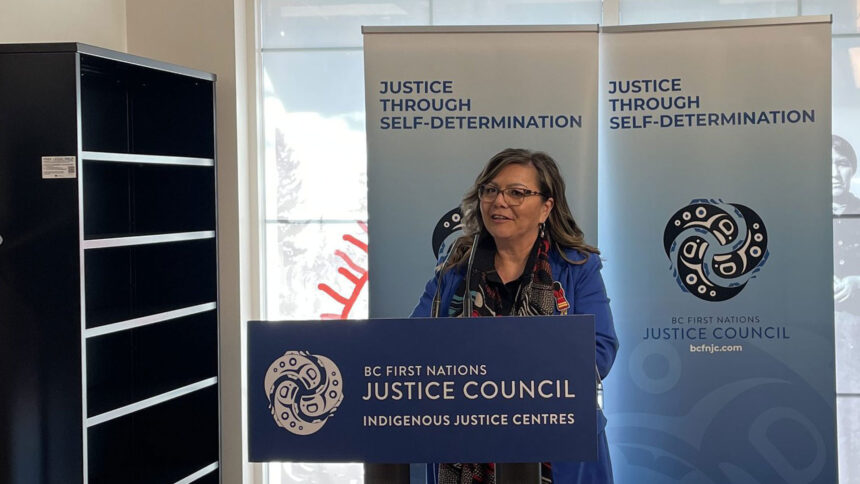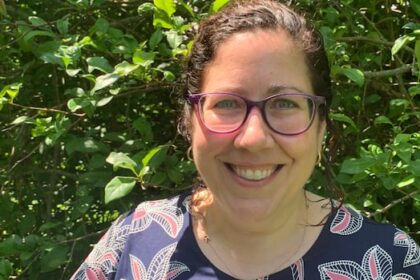Edith Fortier vividly remembers the time several accused shoplifters were sent to her Kamloops non-profit. The thieves, it turned out, were Indigenous seniors who could not afford to eat, the restorative justice manager with Four Circles Justice Society tells The Wren. They relied on food banks to get by — but said they had to start eating pet food, too. “They couldn’t afford to survive on their pensions,” Fortier says. “They’d get extra dog food or cat food so they could eat it just to survive.” Police arrested them after they “took some meat because they were hungry, and some other things to make a meal with” — and they were charged with shoplifting. In a subsequent email, Fortier explains the seniors had been “too ashamed to let their family or friends know” of the cases roughly three years ago. But instead of court hearings, criminal records or jail time, the seniors received a different kind of justice: restorative justice. Prosecutors referred them to Fortier’s organization. A Secwépemc approach to justice, accountability and healing Formerly known as the Secwépemc Community Justice Program, Four Circles Justice Society runs an Indigenous-based conflict resolution program. It’s tailored to Indigenous communities in the greater Kamloops area. Although it’s not available for the most serious violent offences — such as murder, sexual assault or aggravated assault — it can be used for lesser crimes. Eligible offenders attend a talking circle, where they find support from their Secwépemc community and access to other services. In the shoplifting seniors’ cases, that meant addressing the underlying poverty and hunger that led them to steal in the first place. A cloth with the four colours of the Medicine Wheel and traditional medicines is laid out on a floor at Four Circles Justice Society in Kamloops. Photo courtesy Four Circles Justice Society. It’s just one example of the many types of cases Four Circles has taken on over its roughly 25 years. The Indigenous restorative justice model “seeks to repair harm,” the federal justice department says, by creating a way “for those harmed and those who take responsibility for the harm” to communicate about their needs after a crime. In effect, restorative justice focuses on creating conversations between victims and offenders about the circumstances and impact of the offence. In the case of Indigenous communities, a restorative justice approach can serve as an alternative to the formal court process — offering a more holistic, healing-focused environment. “Restorative justice seeks to repair the harm caused by crime and violence,” explains Lucy Johnson, an Indigenous justice worker with Four Circles Justice Society. “So in the past, the criminal justice system has focused on punishing offenders and removing them from society. Restorative justice does the opposite.” The approach aims to reduce the harm offenders cause to their victims and communities, she says, and at the same time can actually prevent people from re-offending. The model’s wide range of tools include everything from peace-making support to Elders’ councils, healing and sentencing circles, conflict resolution, community justice committees and mediation. Indigenous restorative justice increasingly widespread Four Circles Justice Society is far from the only group helping Indigenous people avoid courts and prison, and get a chance at healing and community. The B.C. First Nations Justice Council (BCFNJC) — where Fortier sits on the steering committee — lists 33 Indigenous restorative justice organizations in the province. A map of the province lists more than 30 third-party Indigenous restorative justice organizations, in addition to 15 Indigenous Justice Centres. Map courtesy of B.C. First Nations Justice Council. Indigenous restorative justice organizations often offer programs such as peacemaking circles or community justice forums, often with an emphasis on local traditional values and practices. “The programs provide cultural alternatives to mainstream justice processes in appropriate circumstances,” B.C.’s justice ministry website states. “Programs are working to lower the high rates of victimization, crime and incarceration among Indigenous people.” On its website, the Assembly of First Nations said restorative justice “contrasts to more punitive approaches where the main aim is to punish the offender, or satisfy abstract legal principles.” But the national organization also argues that on top of such common restorative practices, systemic reforms should not only start after Indigenous people enter the justice system. “Rather than focusing solely on programs such as sentencing circles and Gladue reports, there is a need for a comprehensive rethinking of restorative justice,” the AFN states on its website, “based on the reclamation of First Nations legal traditions and laws as a holistic way of addressing overrepresentation.” Reconnection with community and land Rosanne Casimir, Kúkpi7 (Chief) of Tkʼemlúps te Secwépemc, says Indigenous restorative justice enables healing to happen, by using Indigenous-led traditions and involving offenders’ own community and families. Instead of punishment, the approach focuses on “how to restore relationships that are broken,” she says. Casimir tells The Wren a key element of this healing process is reconnection — not only of the offender with their community, but also a connection with the land and traditional healing. “Someone did something wrong,” she says. “It’s not only hurting themselves, it’s hurting someone in their family.” But that requires a lot of reflecting about how things can be restored to balance, she says, and how to heal relationships harmed by an offence. As she sees it, communities also share a responsibility — and play a key role — in the healing process between offenders and those they hurt. Tkʼemlúps te Secwépemc has its own restorative justice worker who supports people through the process. They also offer wraparound services aimed at health, wellness and safety, Casimir says. Tkʼemlúps also offers legal and cultural support services, which the nation hopes can help lead to restorative justice and healing. Diversion away from courts sparks controversy in some B.C. communities The country’s courts have made some reforms in an attempt to reduce the disproportionate number of Indigenous people in the justice system, from courts to prisons. Recently, however, some of those measures have sparked controversy from critics who allege they’ve created a so-called “revolving door” of re-offenders being released due to bail reforms and mandatory consideration of Indigenous defendants’ circumstances in sentencing. But studies from Canada’s justice department have concluded that such policies have helped address the overrepresentation crisis. Changes to one section of the Criminal Code, for instance, state that judges sentencing an offender should consider “all available sanctions other than imprisonment” that are reasonable in the circumstances, “with particular attention to the circumstances of Aboriginal offenders.” It’s known as the Gladue principle — named after Jamie Gladue, a young Cree and Métis woman convicted of killing her spouse at age 19, who appealed her case to the Supreme Court of Canada in 1999 — and it’s led to judges receiving reports explaining the individual life experiences of Indigenous defendants convicted of crimes, before they’re sentenced. There are also now Gladue courts, which exclusively handle Indigenous defendants’ cases, but only when the accused plead guilty. Ottawa has also funded other community-based justice projects, for instance the B.C. First Nations Justice Council — which has opened 15 Indigenous Justice Centres across B.C., most recently including one in Kamloops on Feb. 4. How circles work Drummers sing at the opening of a new Indigenous Justice Centre in Kamloops on Feb. 4, one of 15 across the province. Photo: Macarena Mantilla/The Wren. Four Circles Justice Society offers a range of services — from a community justice forum to peace-making circles, and a healthy relationship program. How exactly they work with Indigenous youth and adults can vary from case to case. Circles in the community often include offenders referred to them, their supporters, and victims coming together to talk about what happened, come to an agreement, and in some cases pay for the harms caused. Johnson says offenders are often referred to the organization by Crown prosecutors after defendants are charged, in cases where they believe an alternative to criminal court would be better. However, she emphasizes, if the accused doesn’t follow the alternative justice program, they must go back to court. Referral to restorative justice can also sometimes come from police, schools, other organizations, or even in some cases from individuals self-referring. There are strict rules about who qualifies for the diversion program, however — for example, in shoplifting cases, they cannot have any previous offences, and the theft must have been less than a certain value. To participate, the accused also have to accept responsibility for their actions. They then sign a contract stipulating various conditions to comply with. If they complete the contract, Crown counsel files a stay of proceedings — and their charges are dropped. “If they successfully complete whatever was agreed to after the circle then they would not have a criminal record,” Fortier writes in an email, but the incident may still appear in police systems. Some examples of qualifying offences include theft under $5,000, mischief, fraud, forgery, possession of stolen property, causing a disturbance, auto theft, and several other offences — up to and including assault. But they exclude more serious violent convictions, or high-risk offenders or those needing psychological assessments. In all cases Four Circles Justice Society accepts, offenders must write a letter of apology. Other conditions can include doing community service work, or paying for damage done or property taken. “We asked them if we could have a circle with someone, then they have to agree,” Fortier say. “So they have to be accountable for their actions and their behaviors. “From there we meet with them.” If the offender is young, they might also be asked to write an essay or research assignment about their crime and how it affected the wider community — and what they would do differently in the future. The program offers participants a chance to understand the consequences of a criminal record — and the chance to not have one at all. In some cases, conditions might also include asking the offender to donate a work of their art to help Elders. Once a restorative justice circle starts, participants discuss the exact nature of the offence and its impact. Non-profit staff interviews those involved in the crime, and the information is brought to the circle. In the case of shoplifters, Fortier says most offenders cannot afford to pay anything back by way of restitution. In those instances, they instead do work-service hours in the community, with the required hours proportionate to the cost of what they stole. Sometimes that service work can involve helping Elders. For many victims, crimes ‘affected them and their whole family’ Chairs are arranged in a talking circle for a community justice forum, one of Four Circles Justice Society’s programs in Kamloops, B.C. The goal of such measures is to change offenders’ behaviour so it does not continue. With young people, Fortier said workers try to make sure they understand the impact of their actions, as well as how a criminal record could impact their future. The group can provide other services such as counseling, depending on the situation. The program deals with any kind of offences except murder, aggravated assault, and those involving weapons. Fortier says it’s helped decrease the number of people committing less serious offences in the community. But while severe crimes are not qualified in most programs, restorative justice isn’t just for petty crimes like theft or fraud, either. Some cases are life-and-death tragedies — in one instance Fortier cites, impaired driving causing death. The victim’s family agreed to join a circle with the driver “to talk about how they felt when their loved one died, and how it’s affected them and their whole family,” she says. “They can say that to the offender.” Circles like the ones facilitated by the Four Circles Justice Society can also help participants on all sides understand the root causes of a crime — and potentially how it could be prevented from happening again. According to Fortier, working with offenders has in fact reduced recidivism. “There’s a lot of real hard work that goes into it for the individual that has to go through those steps towards accountability,” she says. “Because there’s usually a lot of cultural work that is asked of them … dealing with themselves, their heart, learning all those steps, that reconnection. “We want to change the behavior so that they don’t continue to do this anymore.” ‘We’re not the only community’ While restorative justice may be controversial to some, there is no controversy over the data showing Indigenous people are significantly overrepresented in Canada’s justice system — not only as offenders, but importantly also as victims. B.C. Corrections data shows 36 per cent of the province’s prison population are Indigenous — despite only making up six percent of the adult population. And country-wide, recent Statistics Canada research found Indigenous peoples’ incarceration rate is nine times more than for non-Indigenous people. The overrepresentation is even more stark for women in Canada’s prisons. The Correctional Service of Canada says Indigenous women make up half of all federally incarcerated women — ten times higher than Indigenous people’s share of the total population. The overrepresentation of Indigenous people in the criminal justice system is a crisis Tkʼemlúps te Secwépemc has been forced to address. But they’re not the only First Nation wrestling with the problem. “We’re not the only community … working on resolutions of overrepresentation,” Casimir says. That’s why it’s essential to advocate alongside other nations as a unified voice. Research shows a link between violent victimization and colonial policies. Those links include the legacy of the residential “school” system, institutionalized racism, the discriminatory impacts of criminal justice policies, and Indigenous people being marginalized socially and economically. Such colonial policies interfered with and disrupted family structures and caused intergenerational trauma — traumatic experiences passed from survivors to their descendants — according to the Truth and Reconciliation Commission. An estimated 150,000 Indigenous children in Canada attended residential “schools,” the last of which closed in the late 1990s. In 2015, the commission concluded that “the actions of the federal government in attacking and attempting to destroy Aboriginal cultures and languages … amounted to cultural genocide” — and that such policies are “an acknowledged crime against a racial group.” The inter-generational trauma of IRS survivors is linked to a wide range of issues, from parenting struggles to substance abuse, violence, poverty, and involvement in the criminal justice system. These factors have played a major role in why there is an overrepresentation of Indigenous peoples in the system, Canada acknowledges. ‘Breaking down those barriers that keep people isolated and hurting’ Such colonial policies and mindsets have also isolated Indigenous people from their own cultures, communities and traditional territories that could help break the cycles, Casimir says. “It’s truly about reclaiming those connections to land, but also each other. It’s also about breaking down those barriers that keep people isolated and hurting.” The issue is not just about Indigenous people who commit crimes, however. Many times, they are the victims. First Nations people are more likely to experience violence compared to the rest of the population, according to Statistics Canada. The federal justice department estimates Indigenous people aged 15 and older are more than twice as likely to be victims of violence, according to a 2019 general social survey. Indigenous people were six times more likely to be victims of homicide than the rest of the population, according to Statistics Canada data. Research by the Assembly of First Nations found Indigenous women are four times more likely to be victims of violence, compared to non-Indigenous women — and make up 16 per cent of all female homicide victims. Helping offenders ‘truly heal, and to be accountable’ The federal justice department admits its current system “does not work for Indigenous peoples, does not address their needs, and cannot be ‘adapted’ to suit Indigenous communities.” In its 2023 report Indigenous Justice Strategy: What We Learned, the ministry acknowledged a need for “community-based justice solutions that use community-centric restorative justice models such as circles for healing and sentencing.” Johnson, with Four Circles Justice Society, says such alternative measures have helped slowly reduce Indigenous overrepresentation in courts and prison, but also importantly to hold people accountable without permanent criminal records. “All of us make mistakes,” she says. “What this is about is to try to fix that mistake by giving back to the community — because you cost the community something when you did your offence.” In the organization’s programs, such as its community justice forum, crime victims must first be willing to sit down with offenders. But for those willing, once they are in a controlled and safe environment, they’re offered a space to discuss how the crime hurt them. Together, both parties try to develop a plan to redress the harms caused by the offence. “Sometimes this can be incredibly powerful for the offender, because they oftentimes don’t really ever think about the aftermath,” Johnson says. “They just think about the immediate — but they don’t see how this affects the person afterwards.” It’s not just offenders finding healing. In spaces like victim circles, the experience can be liberating, she said. “Because they get a chance to actually say these things to an offender, as opposed to in court.” Offenders, too, have a chance to tell their own story and reflect on their actions. “They can express remorse too, and repair the harm,” Fortier explains. “Then that makes them feel a lot better.” In these circles, a lot of things can happen. And they’re not just for those on trial — former prisoners can access the circles as part of reintegrating back into the community. “The ones that were harmed would say, ‘We don’t want them back in a community,’ and they’re really mad about what happened,” Fortier says. “Once they’ve been in a circle, they really change … they get a better understanding of what happened and why it happened. “In one case, the person was even hugging the offender after they were crying together.” Indigenous Elders and Knowledge Keepers are often included in the non-profit’s circles. For youth who grew up in government care or foster homes, many never had access to traditional teachings and struggle with their self-identity, Fortier says. “They’ve never grown up in their community,” she explains. “When they come back, then they’re more accepted.” The organization connects participants with their culture and where they came from. Elders share traditional teachings. “It’s really important for individuals to truly heal, and to be accountable for their actions,” Casimir says. “but also to be supported through that journey — for understanding and awareness, but also for the safety of themselves and their community.” ‘It helped to get the family together’ For Fortier, Indigenous restorative justice has proven its worth — both in reducing crimes, healing community wounds, but also understanding why some people break laws in the first place. In the example of the shoplifting seniors who went through the process, she says, the results spoke for themselves. In the place of jail and criminal records, they performed 10 hours of community service, and got $50 grocery gift certificates, Fortier says. “No further action was needed,” she recalls in an email. “Each referral or case is individualized, never the same.” But perhaps most importantly, the Secwépemc members got better-connected to their communities — and their own loved ones, who they’d been ashamed to tell about their hunger. “Their family didn’t know that they were struggling through that,” Fortier says. “So then it helped to get the family together — so they support each other after.” Story by Macarena Mantilla, Local Journalism Initiative Reporter – The Wren Continue Reading
Indigenous restorative justice programs provide offenders an alternative to court or prison

Leave a Comment










